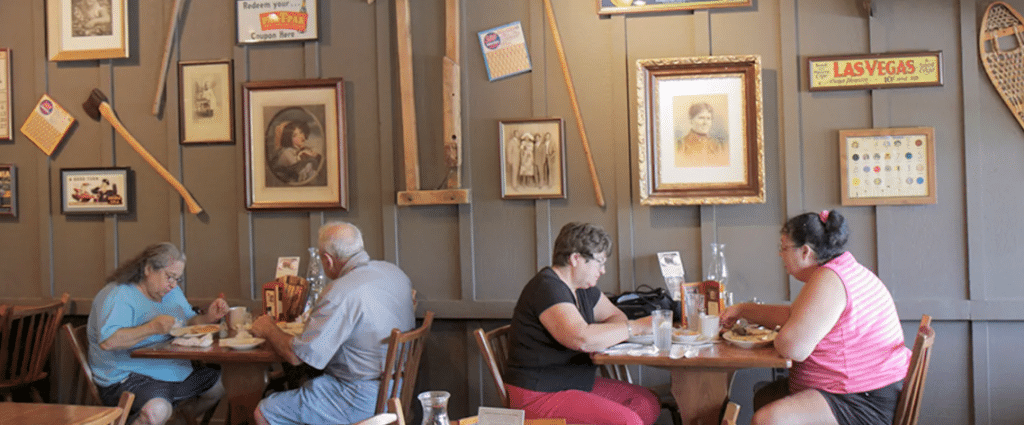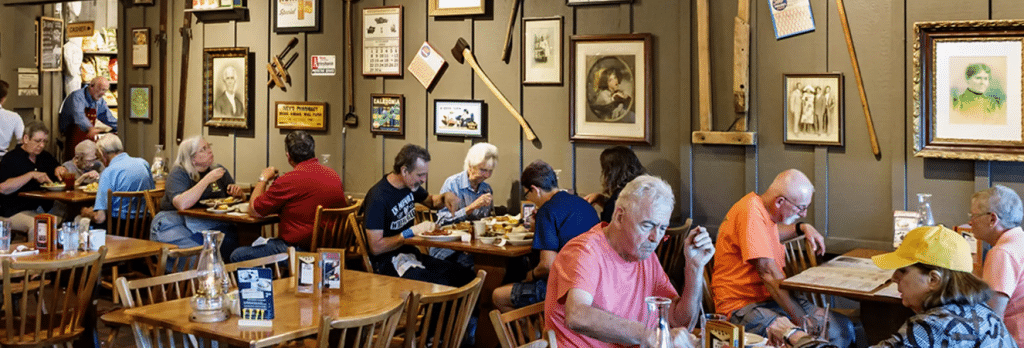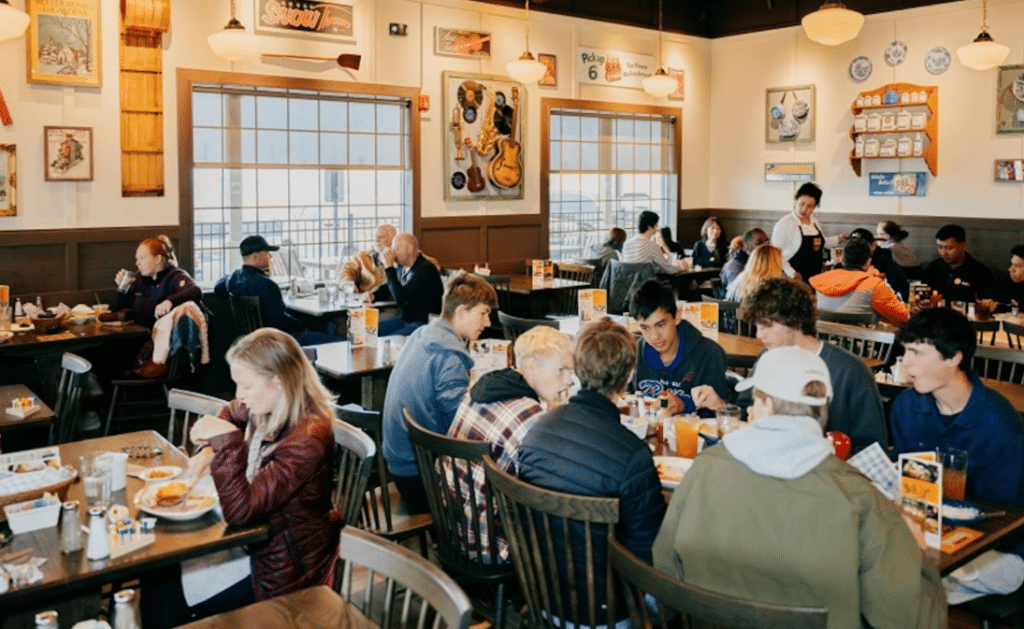The Branding Blunders That Broke the Barrel: Cracker Barrel’s “Bud Light Moment” and the Corporate Curse of
Misreading the Room

By David R. Editor at Misleading.com
In the annals of corporate self-sabotage, few things rival the spectacle of a legacy brand torching its own identity in the name of “modernization.” It’s a ritual now so common it deserves its own quarterly earnings line item: “Goodwill impairment due to marketing hubris.”
Enter Cracker Barrel, the Southern comfort chain that once stood as a roadside shrine to Americana kitsch. Under the stewardship of CEO Julie Felss Masino, the company recently unveiled a rebrand so sterile, so soulless, it triggered a backlash that tanked its stock by nearly 15% in a single day. The culprit? A new logo—text-only, minimalist, and devoid of the iconic “Old Timer” figure who had leaned against a barrel since 1977. The move was part of a broader transformation strategy aimed at making Cracker Barrel “relevant for today and tomorrow.” Instead, it became a case study in how not to modernize a heritage brand.
This wasn’t just a logo change. It was a cultural lobotomy.
Cracker Barrel’s “Bud Light Moment”
The parallels to Bud Light’s 2023 marketing implosion are impossible to ignore. Like Bud Light, Cracker Barrel attempted to pivot toward a younger, more progressive audience—only to alienate its core customer base in the process. The backlash was swift and merciless. Social media erupted with hashtags like #NotMyCrackerBarrel and #BringBackTheBarrel. Country singer John Rich warned of a “Bud Light moment.” Steak ‘n Shake piled on, accusing Cracker Barrel of “deleting its personality altogether.”
The financial fallout was immediate. Cracker Barrel lost nearly $200 million in market value. Investors, sensing a disconnect between brand identity and consumer loyalty, fled. The company’s attempt to reassure stakeholders—claiming the response was “overwhelmingly positive”—only deepened the perception that leadership was out of touch.
The Psychology of Brand Ownership
Marketing experts were quick to diagnose the failure. Kevin Dahlstrom, a veteran CMO, called the rebrand a “fiasco,” noting that Cracker Barrel had achieved the holy grail of branding: emotional ownership. “When you have that,” he wrote, “you NEVER EVER abandon it. You only double down.”

This echoes the lessons learned from Bud Light’s misstep. In April 2023, the beer brand partnered with transgender influencer Dylan Mulvaney in a social media campaign. The backlash from conservative consumers was swift, leading to boycotts, plummeting sales, and the resignation of key marketing executives. The campaign wasn’t controversial because it supported inclusion—it was controversial because it disrupted the brand’s perceived identity without strategic alignment.
Bud Light had long been “hired” by consumers for low-stakes social rituals: tailgates, barbecues, and frat parties. Its pivot toward identity politics—however well-intentioned—introduced friction into a category defined by familiarity. The result? Neither growth nor goodwill.
Heritage vs. Reinvention: A False Binary
Cracker Barrel’s rebrand was framed as a return to its 1969 roots. But the removal of the Old Timer figure—widely associated with “Uncle Herschel”—was seen as a symbolic break from the chain’s Southern heritage. The new logo, critics argued, looked like it belonged on a fintech app, not a country store.
This tension between heritage and reinvention is not unique to Cracker Barrel. Legacy brands across industries have struggled to modernize without alienating loyal patrons. Consider:
- Gap’s 2010 logo redesign, which lasted six days before being scrapped due to public outcry.
- Tropicana’s 2009 packaging overhaul, which led to a 20% drop in sales and a $30 million loss.
- New Coke (1985), the OG of branding blunders, which was pulled after just 79 days.
In each case, the brand underestimated the emotional resonance of its existing identity. Consumers don’t just buy products—they buy stories, rituals, and symbols. Strip those away, and you’re left with a commodity.

The DEI Dilemma

Cracker Barrel’s woes were compounded by criticism of its Diversity, Equity, and Inclusion (DEI) initiatives. Conservative group America First Legal filed a complaint with the EEOC, alleging race- and gender-conscious hiring practices. While the company defended its values, the timing of the logo change—amid broader cultural debates—fueled perceptions of a “woke” pivot.
This mirrors the Bud Light saga, where the brand’s attempt to signal inclusivity was interpreted as political posturing. The lesson? DEI efforts must be authentic, strategic, and aligned with brand values. Otherwise, they risk becoming lightning rods for backlash.
The Five-Pillar Fallacy
CEO Julie Masino outlined a five-pillar transformation strategy: refining the brand, optimizing the menu, evolving the store experience, winning in digital, and elevating the employee experience. On paper, it’s a textbook playbook. In practice, it reads like a consultant’s PowerPoint divorced from consumer reality.
Masino’s background—Taco Bell, Mattel, Starbucks—suggests a bias toward trend-driven innovation. But Cracker Barrel isn’t a cupcake boutique or a fast-casual chain. It’s a nostalgia factory. Its value lies in its resistance to change, not its embrace of it.
What Legacy Brands Can Learn
So what’s the path forward for brands like Cracker Barrel?
- Know Your Core: Before chasing new demographics, understand what makes your brand beloved. Emotional resonance trumps trendiness.
- Test Before You Leap: Pilot changes in select markets. Use A/B testing. Don’t bet the brand on a single rollout.
- Narrate the Journey: If you must evolve, bring consumers along. Frame changes as enhancements, not erasures.
- Avoid Identity Whiplash: Don’t swing from rustic charm to sterile minimalism overnight. Gradual evolution builds trust.
- Own the Missteps: If backlash occurs, acknowledge it. Transparency builds credibility. Gaslighting your audience—claiming “overwhelmingly positive” feedback amid a stock plunge—is a recipe for reputational ruin.
The Risk of Going Generic
Cracker Barrel’s new logo is emblematic of a broader trend: the homogenization of brand identities. In the quest for digital compatibility and aesthetic minimalism, companies are shedding their quirks, their stories, their souls.
Thanks for reading our deep dive into the art of corporate confusion. At Misleading.com, we don’t just dissect the blunders—we invite you to challenge them. Join the conversation, share your take, and help us hold the narrative accountable.
We’ll leave you with this:
When everything looks the same, the only thing left to compete on is price.
That’s not branding. That’s surrender.





